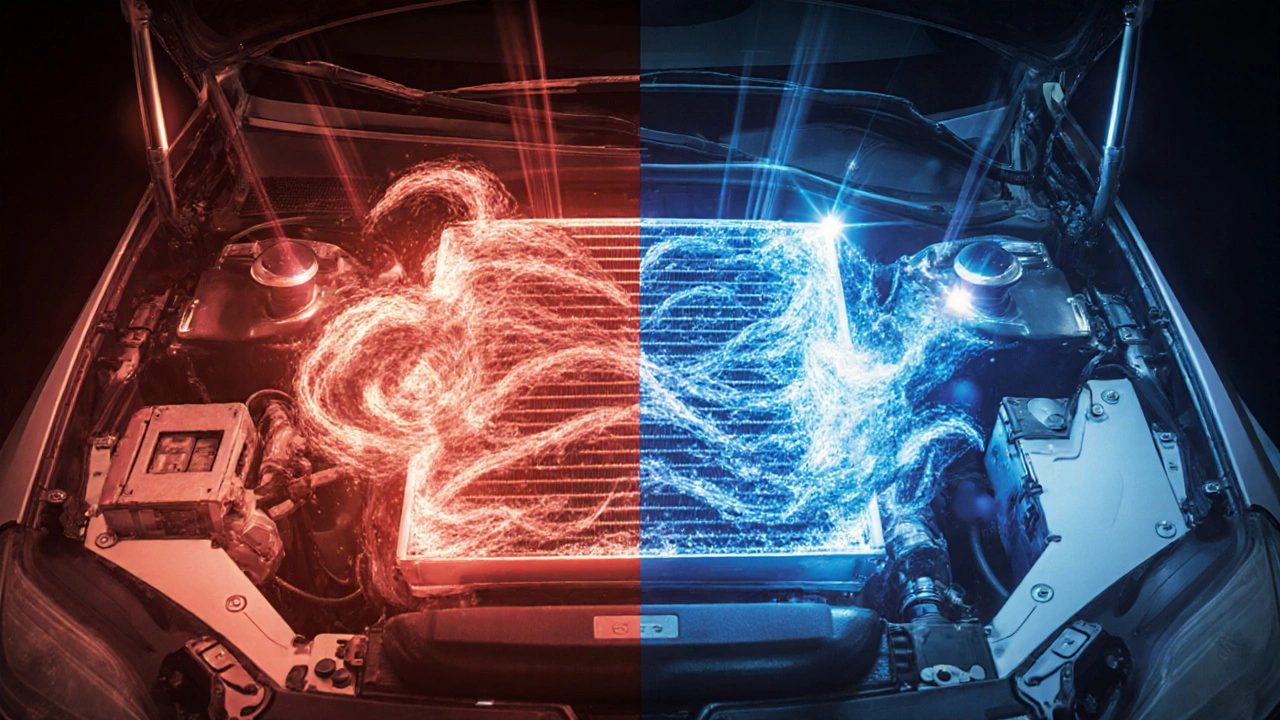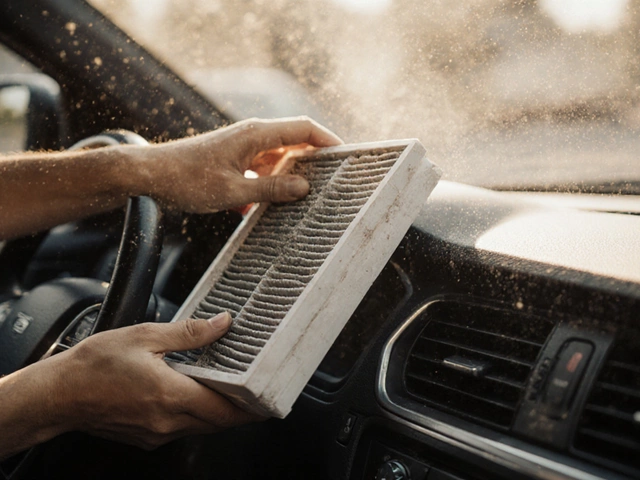AC Cooling Time Estimator
Enter your vehicle's conditions to estimate when your AC will start cooling after replacing the cabin air filter.
Estimated Cooling Time
Key Takeaways
- Most modern cars feel cooler within 5‑10 minutes after a new cabin air filter is fitted.
- Cold ambient temperatures, a fully charged refrigerant system, and a clean blower motor can shorten that time to just a couple of minutes.
- If the AC still blows warm air after 30‑45 minutes, the issue is likely unrelated to the filter.
- Running the fan on high for a few minutes after installation helps purge stale air and speeds up airflow.
- Regular filter swaps keep the overall cooling efficiency up to 15 % over the vehicle’s life.
What the air filter does for your car’s AC
When you hear the term air filter is a component that traps dust, pollen, and other particulates before they reach the cabin’s ventilation system. It also protects the blower motor, evaporator coil, and temperature sensor from clogging. A clean filter lets more air move through the HVAC (heating, ventilation, and air‑conditioning) unit, which means the refrigerant can absorb heat more efficiently and the cabin cools faster.
Why changing the filter can affect cooling instantly
Most drivers expect the AC to start blowing cold air the moment they turn the knob on. In reality, the system needs a steady flow of fresh air to distribute the chilled refrigerant. A clogged filter creates a pressure drop, reducing airflow by up to 30 %. That reduction forces the blower motor to work harder, which can raise its temperature and temporarily limit its output. Swap the filter for a clean one, and the airflow restriction disappears - the blower can spin at full speed again, and the evaporator receives the volume of air it was designed for. The result is an immediate perception of cooler air.

Typical timeframes after a filter swap
| Condition | Typical Wait Time | Why it matters |
|---|---|---|
| Warm outdoor temperature (above 25 °C / 77 °F) | 5‑10 minutes | Engine and AC compressor already running; airflow boost is the main factor. |
| Cold outdoor temperature (below 10 °C / 50 °F) and AC set to ‘max cool’ | 2‑5 minutes | Lower ambient heat means the evaporator can reach its target temperature faster. |
| Heavy traffic stop‑and‑go (engine idling) | 8‑12 minutes | Compressor speed drops at idle, so cooler air takes longer to build up. |
| System already low on refrigerant | 30‑45 minutes (or no improvement) | Airflow improves, but the refrigerant can’t absorb enough heat. |
Factors that speed up or delay AC recovery
Not every car behaves the same way. Several variables influence how fast you notice the chill after a filter change:
- Filter type and rating: A high‑MERV or HEPA cabin filter offers finer filtration but can add a small extra pressure drop. Pick a filter rated for your vehicle’s airflow specs.
- Blower motor health: A motor with worn bearings may already be near its output limit; a clean filter gives it just enough extra headroom to feel a difference.
- Refrigerant charge: Low refrigerant masks any airflow gains because the evaporator can’t get cold enough, regardless of how much air passes through.
- Thermostat setting: Setting the AC to “max cool” forces the system to work harder, revealing benefits faster.
- Ambient humidity: High humidity adds extra latent heat load, so the evaporator takes longer to reach the dew point.
Step‑by‑step: What to do after you replace the filter
- Close all windows and doors to keep outside air from diluting the cabin air.
- Turn the ignition on and let the engine idle for a minute - this primes the compressor.
- Set the climate control to ‘AC’, choose the coldest temperature, and set the fan to High.
- Run the system for 3‑5 minutes. You’ll hear a slight increase in fan noise - that’s the blower pushing more air through the fresh filter.
- After the initial burst, lower the fan to your normal comfort level. If the air feels noticeably cooler, the filter swap was successful.
- If the air is still warm after 30 minutes, check the refrigerant level or inspect the AC fuse and pressure sensor.

Common mistakes and how to avoid them
Even a simple filter swap can go wrong if you’re not careful. Here are the usual slip‑ups:
- Installing the filter backward: Most filters have an arrow indicating airflow direction. Reverse it, and you create a bottleneck that can feel worse than a clogged filter.
- Using the wrong size: Cabin filters are often vehicle‑specific. A slight size mismatch forces you to force the filter into place, creating gaps that let unfiltered air in.
- Skipping the pre‑check: Never replace a filter when the HVAC blower is still running. Turn the fan off first to avoid pulling dust into the system.
- Neglecting the evaporator coil: A dirty coil can look like a filter problem. If you notice a musty smell after the swap, the coil likely needs cleaning.
When to call a professional
If you’ve followed the steps above and the AC still refuses to cool, it’s time to bring in a technician. Look for these red flags:
- Continuous warm air after 45 minutes of running.
- Audible hissing or grinding from the compressor.
- Visible oil residue around the AC hoses.
- Error codes on the dash (often ‘AC system malfunction’).
A qualified mechanic can test refrigerant pressure, examine the expansion valve, and ensure the blower motor’s electrical connections are solid. Remember, a clean filter is only part of the HVAC puzzle - the system will only perform at its best when every component works together.
Bottom line
In most cases, you’ll start feeling colder air within the first five minutes after swapping a dirty cabin air filter for a fresh one. Running the fan on high for a short burst helps push the new filter’s clean air through the evaporator, letting the refrigerant do its job faster. If the cooling lag stretches beyond half an hour, the culprit is probably elsewhere - low refrigerant, a failing compressor, or a clogged evaporator coil. Keep a schedule (every 12‑15 000 km or once a year, whichever comes first) and you’ll protect both the AC’s efficiency and the overall health of the vehicle’s HVAC system.
